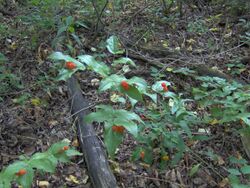Biology:Prosartes trachycarpa
| Roughfruit fairybells | |
|---|---|

| |
| Scientific classification | |
| Kingdom: | Plantae |
| Clade: | Tracheophytes |
| Clade: | Angiosperms |
| Clade: | Monocots |
| Order: | Liliales |
| Family: | Liliaceae |
| Genus: | Prosartes |
| Species: | P. trachycarpa
|
| Binomial name | |
| Prosartes trachycarpa S. Watson
| |
| Synonyms[1] | |
| |
Prosartes trachycarpa, the roughfruit fairybells,[2] rough-fruited fairybells or rough-fruited mandarin, is a North American species of plants in the lily family.[3][4] The species is widespread, known from British Columbia to Ontario and south to Arizona and New Mexico.[4][1] One isolated population was reported from Isle Royale in Lake Superior.[4]
Description
This herbaceous perennial is 30 centimeters (12 in) to 80 centimeters (31 in) in height. The stems are only sparingly branched and have a softly fuzzy texture when young and become smooth or nearly so with age. The leaves are alternate and are about 4 centimeters (1.6 in) to 12 centimeters (4.7 in) long.[4]
The flowers are delicate and hang down from the stem tips, each flower has four pedals. The berry is larger than a Saskatoon, pincherry or chokecherry, about the size of a grocery store cherry or small grape. The rough-fruited fairybell can be found in the same locale as other native fruits such as Saskatoons and chokecherries.[5][6][7] Berries begin yellow, then orange and when fully ripe are red, often with all three colors on the same raceme.[8] Typically 2—3 berries grow on each stem tip. The surface of the fruit feels fuzzy and velvety.[4] The berries are edible, but bland.[9]
The species is listed amongst plants found in the Prince Albert National Park and Riding Mountain National Park and are considered a common range plant of northern Saskatchewan.[10][11]
Uses
The berries have historically been eaten by Blackfeet Native Americans.[12]
References
- ↑ 1.0 1.1 POWO (2023). "Prosartes trachycarpa S.Watson" (in en). Royal Botanic Gardens, Kew. http://www.plantsoftheworldonline.org/taxon/308681-2.
- ↑ "Prosartes trachycarpa". Natural Resources Conservation Service PLANTS Database. USDA. https://plants.usda.gov/core/profile?symbol=PRTR4.
- ↑ Utech, F. H., Z. K. Shinwari, and S. Kawano. 1995. Biosystematic studies in Disporum (Liliaceae-Asparagoideae-Polygonateae). VI. Recognition of the North American section Prosartes as an autonomous genus. Memoirs of the Faculty of Science, Kyoto University, Series Biology 16: 1–41.
- ↑ 4.0 4.1 4.2 4.3 4.4 Utech, Frederick H. (5 November 2020). "Prosartes trachycarpa - FNA". http://floranorthamerica.org/Prosartes_trachycarpa.
- ↑ Vance, F.R.; Jowsey, J.R.; McLean, J.S. (1977), Wildflowers Across the Prairies, Saskatoon, SK: Western Producer Books, p. 141, ISBN 0-919306-74-8
- ↑ Vance, F R; J.R. Rowsey; J.S Maclean; F.A. Switzer (1999), Wildflowers across the prairies With a new section on Grasses, sedges and rushes, Vancouver, British Columbia: Western Producer Prairie Books, pp. 25, ISBN 1-55054-703-8
- ↑ Wilkinson, Kathleen (1999), Wildflowers of Alberta A Guide to Common Wildflowers and Other Herbaceous Plants, Edmonton Alberta: Lone Pine Publishing and University of Alberta, pp. 19, ISBN 0-88864-298-9
- ↑ Barr, Claude A. (1983). Jewels of the plains : wild flowers of the Great Plains grasslands and hills. Minneapolis: University of Minnesota Press. p. 67. ISBN 0-8166-1127-0.
- ↑ Stark, Eileen (30 July 2018). "Pacific Northwest Native Plant Profile: Fairy bells (Prosartes spp.)". https://realgardensgrownatives.com/?p=3744.
- ↑ Innvista, Prince Albert National Park, http://www.innvista.com/science/ecology/parks/princeal.htm, retrieved 2008-08-03
- ↑ common range plants of northern Saskatchewan, http://www.saskforage.ca/publications/Northern.pdf, retrieved 2008-08-03
- ↑ Reiner, Ralph E. (1969). Introducing the Flowering Beauty of Glacier National Park and the Majestic High Rockies. Glacier Park, Inc.. pp. 118.
External links
Wikidata ☰ Q7250543 entry
 |



